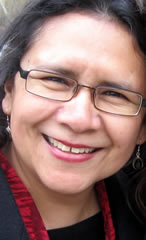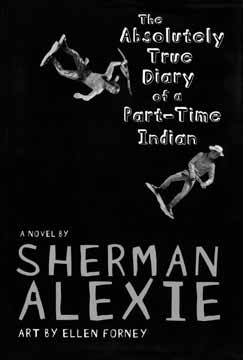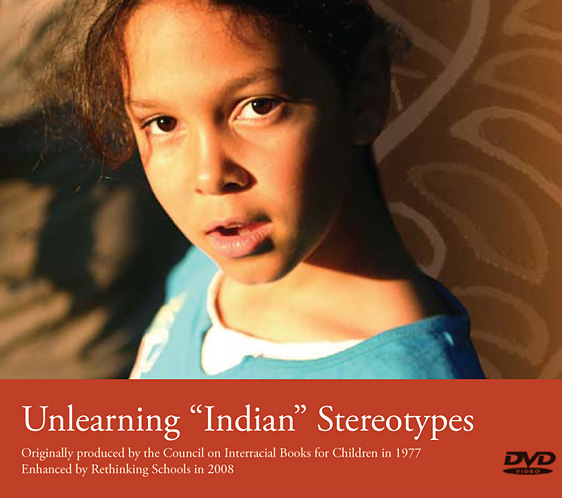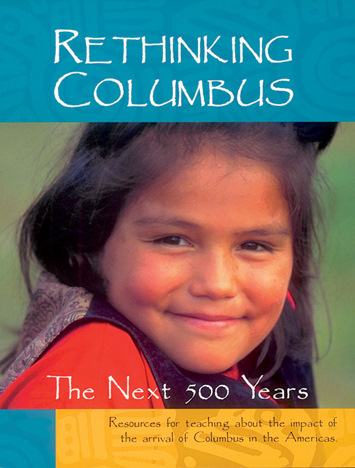 Over the years, Debbie Reese’s work has been an important resource for educators. Her website, American Indians in Children’s Literature, is an authoritative source of analysis, and was one of the country’s “go to” sites when early this year Tucson suppressed the Mexican American Studies program and banned books like Rethinking Columbus.
Over the years, Debbie Reese’s work has been an important resource for educators. Her website, American Indians in Children’s Literature, is an authoritative source of analysis, and was one of the country’s “go to” sites when early this year Tucson suppressed the Mexican American Studies program and banned books like Rethinking Columbus.
Reese has been kind enough to allow us to reprint her articles in our publications—see, for example, “Fiction Posing as Truth,” in Rethinking Our Classrooms, Volume 2; and “Teaching Young Children About Native Americans,” in the curriculum material that accompanies the DVD, Unlearning Indian Stereotypes.
In Reese’s essay and resource listing below, she addresses librarians: “Too many people think that American Indians died off, due to warfare and disease. When the emphasis in library displays is American Indians of the past, you inadvertently contribute to that idea.” This is worth remembering for all educators, at all times—but especially now as we enter the “official” Native American Month. Debbie Reese is tribally enrolled at Nambe Pueblo in northern New Mexico.
Resources for American Indian Month
by Debbie Reese
November is the month that the President of the United States designates as Native American Month. Below are suggestions on how you might get your library ready for parents, teachers and students who come into your library looking for materials on American Indians.
Creating a Library Atmosphere that Welcomes American Indians
In these posts, you’ll find recommended books about American Indians, by age group:
Top Board Books for the Youngest Readers
Top Ten Books for Elementary School
Top Ten Books for Middle School
If you want some guidance on how to help students do research on American Indians, using encyclopedias and websites, see:
Resources for Projects on American Indians
If you’re looking for books and materials about boarding schools for American Indians, here’s some:
Boarding Schools for American Indians
If you want guidelines on how to evaluate the content of a Native site, here’s an excellent page about that:
Guidelines for Evaluating American Indian Web Sites
And, if you want to develop your understandings of the ways that American Indians are not “multicultural” or “people of color”, see:
If you’re looking for a Question/Answer book about American Indians, this one by the National Museum of the American Indian is outstanding:
Did you know that “papoose” is not the American Indian word for baby?
Did you order Louise Erdrich’s newest book in the Birchbark House series? If not, do it today! Chickadee is terrific!
I’ll close with this:
Too many people think that American Indians died off, due to warfare and disease. When the emphasis in library displays is American Indians of the past, you inadvertently contribute to that idea. Librarians are a powerful group of people. You can help Americans be less-ignorant about American Indians.
Research studies show that American Indian students drop out at exceedingly high rates. Scholars attribute this, in part, to their experience with curricular materials in school. Materials set in the past, materials that stereotype American Indians, and materials that are factually incorrect or highly biased against American Indians, cause Native students to disengage from school. Libraries can interrupt that disengagement, or, they can contribute to it…
As human beings, we love to see reflections of ourselves and our hometowns. They can a source of pride or a boost to the self-esteem. But—that is only true if they are accurate. Native people want that, too, but American society has a long way to go to get there.
Libraries can get us there, but we’ll need your help year-round, not just in November. I hope the resources I share in this email will be ones that you spread out, all year long. If you’ve got questions, let me know.
Thanks,
Related Resources
 |
“Why the Best Kids’ Books Are Written in Blood,” by Sherman Alexie. Rethinking Schools magazine, Volume 26, Number 1, Fall 2011. |
 |
Unlearning Indian Stereotypes. Narrated by Native American children, this DVD teaches about racial stereotypes and provides an introduction to Native American history through the eyes of children. Useful for elementary through adult education. |
 |
Rethinking Columbus. More than 80 essays, poems, interviews, historical vignettes, and lesson plans reevaluate the myth of Columbus and issues of indigenous rights. |
